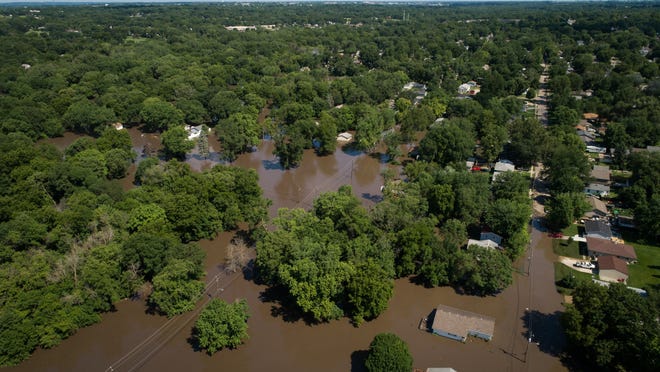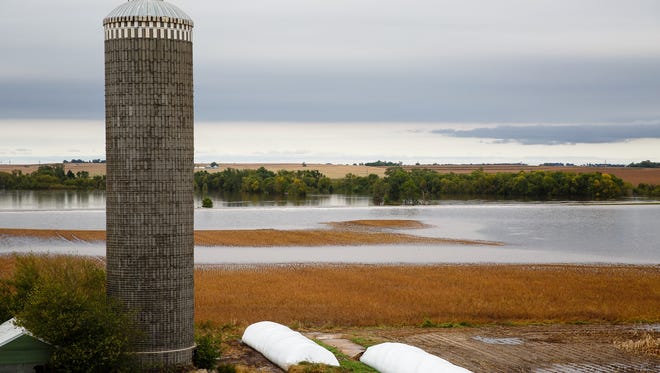Does The Impact Of Climate Change Affect Animals In Iowa
What y'all need to know:The recently released 4th National Climate Assessment contains these warnings for the Midwest and Iowa:
- Crop yields could be reduced due to ongoing changes in seasonal rainfall and the severity of oestrus waves
- A potential 25% driblet in corn yields by the heart of the century
- Urban areas could run across more damaging floods, peculiarly in the spring
- Cleaning upward Iowa's waterways volition become even more than challenging as a shifting climate makes solutions more difficult
- Changes in engineering science volition probable not allow adequate adaptation
A new climatic change report carries grave warnings for Iowa farmers.
Intense heat waves could prevent corn and soybeans from pollinating, leading to greater hazard of crop failure.
Heavy leap rains — likely followed past summer droughts — will tighten an already shortened planting window, exacerbating soil erosion and nutrient runoff that threatens Iowa's drinking h2o.
Productivity could drib to 1980s levels without a pregnant increment in the amount of seed, fertilizers and pesticides needed to heighten a crop.
The grim forecast is role of the Fourth National Climate Cess, a federal study mandated by Congress and completed every four years.
"Any change in the climate poses a major claiming to agriculture through increased rates of crop failure, reduced livestock productivity and contradistinct rates of pressure from pests, weeds and diseases," the written report says.

It could mean upwardly to a 25 percent drop in corn yields by mid-century, a potential hit for Iowa, the nation's largest corn-producing state.
Climate change will cost farming and other U.S. industries "hundreds of billions of dollars" annually by the terminate of the century, according to the written report released this month and written by more than 300 federal and not-federal experts.
The force per unit area on farms brings additional stress for rural communities, whose fiscal fortunes are closely tied to agriculture, the report says.
Climate change has besides brought Iowa benefits for farmers, including increased moisture that held down maximum summertime temperatures, warmer winters, and 9 more than frost-free days since 1901.
Climate alter is likely one reason farmers have seen "tape yields over the past four or five years ... non that we haven't had issues," said David Miller, the Iowa Farm Agency Federation'southward director of enquiry.
Simply "at some point, the negatives will outweigh the positives," Miller said. "The question is how quickly can agriculture suit."
A shift that unmasks warming
Last summertime provides a snapshot of climate change's impact in Iowa: The Des Moines metro area experienced massive flooding in late June, filling thousands of basements with water and sewage and causing millions of dollars in damage.
About eighty families were homeless and 1 man died in the storm.
Farmers struggled with intense leap rains that forced many growers to shift from corn to soybean production. And i of the wettest falls in state history slowed the harvest and raised concerns about mold and toxins that tin make corn unsafe for livestock.
"Over the past 30 years, increased rainfall from April to June has been the most impactful climate trend for agriculture in the Midwest," the report says.
In Iowa, annual average temperatures have increased "more in the winter than in the summer, and more than at night than during the day," said Gene Takle, a retired Iowa Country University climate scientist.
"The enigma we have is that, while in the growing flavor, the night time temperatures are going up, while the daytime maximum temperatures are going downwardly," said Takle, who was an author of the Midwest climate cess. "It's counter-intuitive."

"The excess rain that we're getting in the spring and summer is playing a part in the turn down in extreme temperatures," he said.
More energy is used to evaporate water than to heat the air, holding down maximum temperatures. Simply that's likely to modify.
Rut waves in the Midwest are probable to get hotter — the largest increase nationally —combined with a decline in belatedly summer rainfall, Takle said.
That shift "unmasks the warming that'southward been going on," he said.
A five-mean solar day oestrus wave in primal Iowa at present averages 90 to 95 degrees in 5 out of every 10 years, Takle said.
By 2050, the average heat wave volition climb 7 degrees. And in one case every x years, it will spike 13 degrees, pushing the five-twenty-four hours oestrus wave every bit loftier as 108 degrees.
"Increases in growing-season temperature in the Midwest are projected to be the largest contributing factor to declines in the productivity of U.S. agriculture," the report said.
Extreme weather is on most farmers' minds
Farmers already are adapting to climatic change, while other industries are at the starting gate, says Josette Lewis, an Environmental Defence Fund associate vice president.
"Adaptation hasn't been as potent a message for other economic sectors. It's been more than most mitigation," Lewis said. "And we're starting to see that we need both, beyond the board. That'south what agriculture has been doing for a number of years."
Ray Gaesser, who raises corn and soybeans on 5,000 acres near Corning, says nigh farmers are already "managing for extreme conditions events."
Over the past decade, he'south seen more than intense rain events — iv-inch downpours over an hour or 8 to 10 inches in a day.
"It'southward top of about guys' minds," said Gaesser, who farms with his son, Chris. "Nosotros live with Mother Nature every mean solar day and we're trying to suit."

Like many Iowa farmers, Gaesser has been fighting soil and nutrient erosion for years: calculation terraces on hills to deadening and hold water.
He's decided against tillage — called "no till" — which leaves the soil undisturbed and corn stalks and soybean stubble on the field to reduce soil erosion and build organic matter that increases yields and better absorbs rain.
And he'southward growing cereal rye encompass crops over the winter, which holds soil and nutrients such as nitrogen in place, especially during gully-washing spring rains.
Gaesser and his son also invested in more planting, harvesting and drying equipment to better cope with less time to put in and take out their crops.
"Nosotros're geared up to plant and harvest before and more quickly. And I'm glad nosotros did," Gaesser said.
Climate modify makes Iowa's clean water goals tougher to reach
The report holds apropos news for Iowa most h2o quality: The threat of harmful algal blooms increases with climate alter, thanks to warmer temperatures and heavy precipitation.
Iowa already struggles with harmful algal blooms, which can introduce cyanobacteria into lakes, rivers and streams used for recreation or drinking water, making it dangerous for people and pets to employ.
Iowa is already under pressure to cut the nitrogen and phosphorus leaving the land and contributing to the Gulf of Mexico dead zone, an area of low oxygen that'south unable to support aquatic life during the summer.
Iowa leaders this year agreed to spend $282 million on water quality over 12 years, with nigh $156 one thousand thousand bachelor to add encompass crops, bioreactors, wetlands, saturated buffers and other practices experts say will keep backlog nutrients from polluting Iowa's lakes and streams.
But the money volition trickle in slowly over the start few years and fall curt of the $1 billion experts estimate is needed annually to meet the state'due south clean water goals.
Climate change "makes the mountain Iowa has to climb on water quality a piddling steeper," Lewis said, adding that urban-rural water quality partnerships will abound even more of import.
"Changing climate can exacerbate (challenging) relationships between agriculture and the increasingly urban populations in farm states," Lewis said, pointing to California'due south fight over water during a five-yr drought that concluded last twelvemonth.
"Increasingly, rural landscapes must be part of the solution," she said.
Tin technology overcome striking to yield?
Miller, Farm Agency'south research director, says he expects technological gains will help farmers accost climate modify.
For example, Iowa and Indiana researchers are testing how farmers can capture water and nutrients that run off fields and store information technology for later irrigation, said Chris Hay, a senior ecology scientist at the Iowa Soybean Association.

And improved seed genetics that enable plants to better withstand drought, disease and other growing challenges are helping drive U.South. yields.
Those efforts are expected to improve with CRISPR, factor-editing engineering science that enables scientists to more apace and precisely change seed traits.
But the report warns that technology is unlikely to overcome climate change'south challenges.
"Trends toward warmer, wetter and more humid atmospheric condition provide challenges for field work, increase affliction and pest pressure and reduce yields to an extent that these challenges can exist merely partially overcome by technology," it said.
The biggest challenge raised in the written report for agriculture is "whether nosotros tin maintain productivity gains over the next 20, 30 years," Miller said.
Climate change'southward economic affect
Climate change's economic touch gets sharper focus in the latest national assessment, says Jerry Schnoor, a Academy of Iowa professor in civil and ecology engineering.
The toll is high, from medical expenses and lost work fourth dimension to increased utility bills and storm damage to roads and other infrastructure. Some examples:
LOST Work HOURS: Farthermost oestrus in the Midwest is projected to upshot in losses in labor and associated losses in economic revenue up to $nine.8 billion per yr in 2050, rising to $33 billion per year in 2090.
Harm TO ROADS: The Midwest is among the regions with the largest expected damages to infrastructure, including the highest estimated damages to roads, rise from $three.3 billion per year in 2050 to $6 billion per twelvemonth in 2090. Climate change is projected to increment the costs to maintain, repair and replace infrastructure.
FLOODS:Winter and spring precipitation is important to flood gamble in the Midwest and is projected to increase by up to 30 percent by the end of this century.The average annual amercement from heightened flooding risk are projected to be in excess of $500 one thousand thousand by 2050.
Flooding already has taken a heavy toll on Iowa, costing residents, businesses and farmers about $xviii billion over nigh iii decades, a University of Iowa report shows. The state ranks fourth nationally in the number of floods since 1988.
Source: https://www.desmoinesregister.com/story/money/agriculture/2018/11/30/climate-change-iowa-farm-agriculture-rain-drought-heat-temperature-national-climate-assessment/2115179002/
Posted by: ahrenssaisent.blogspot.com

0 Response to "Does The Impact Of Climate Change Affect Animals In Iowa"
Post a Comment